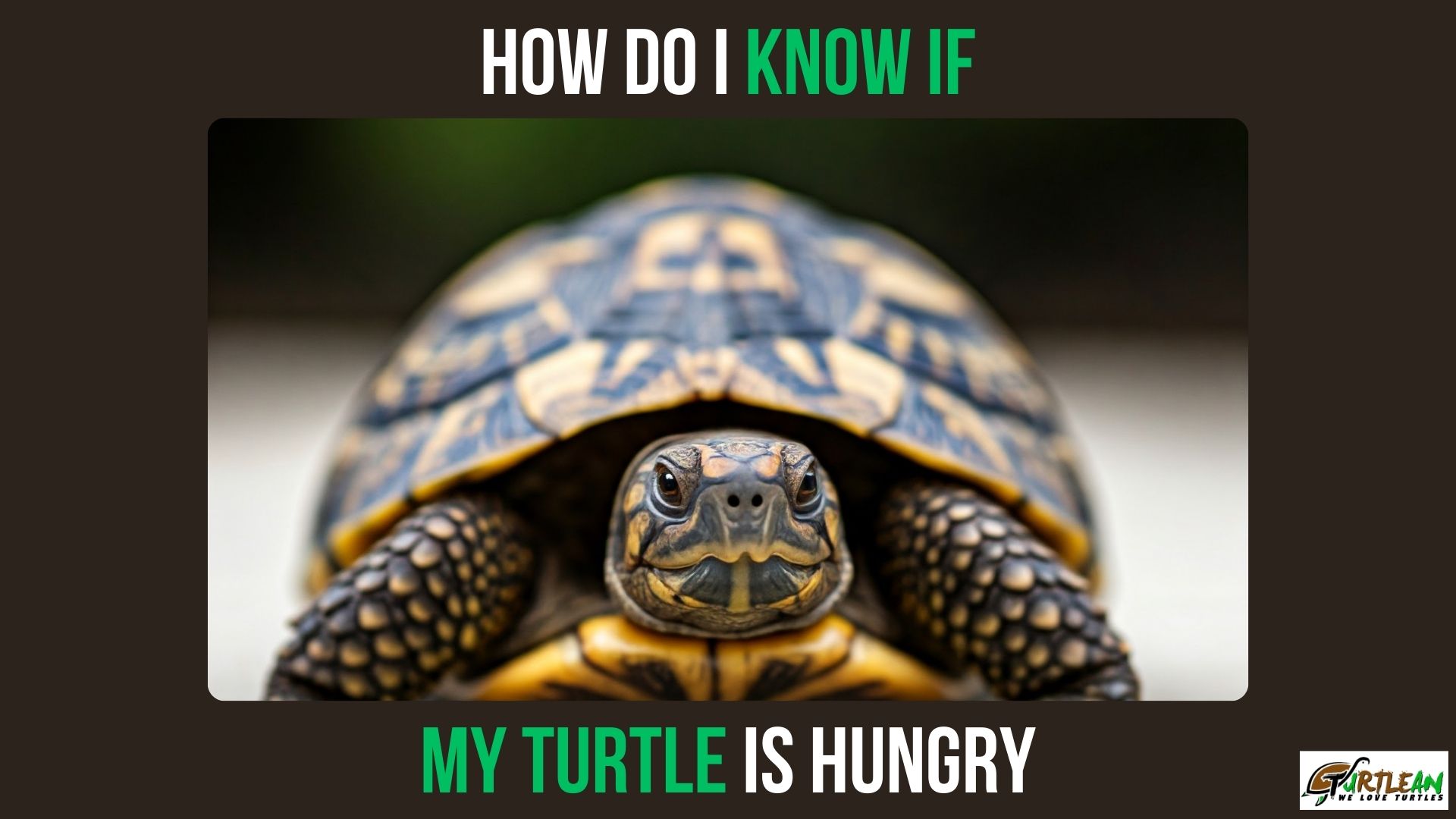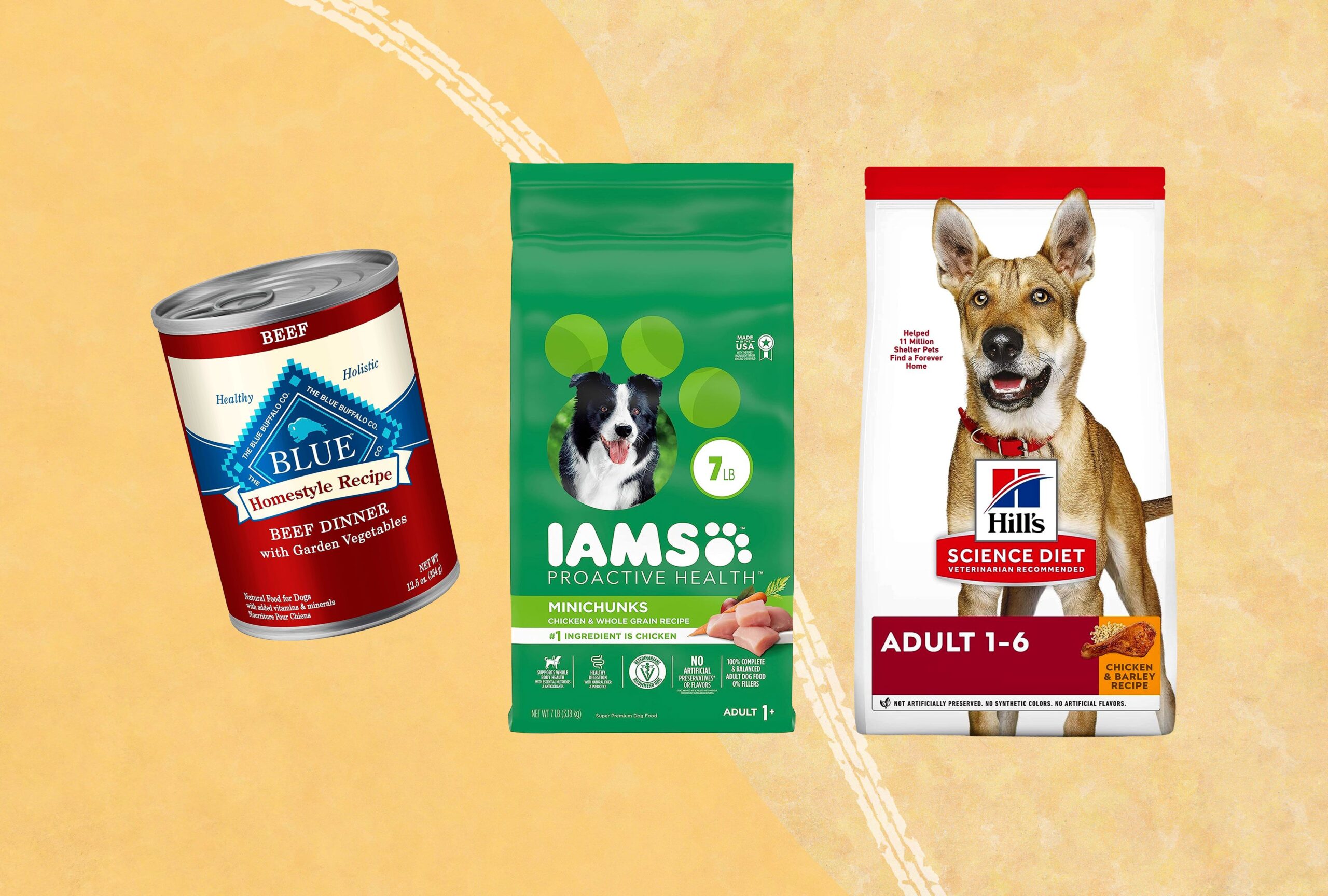A hungry turtle often becomes more active and eagerly approaches when you come near. It may also beg for food.
Turtle owners often worry about their pets’ feeding habits. Recognizing hunger signs helps ensure your turtle’s well-being. An active, alert turtle approaching you is a good indicator of hunger. Observing their behavior can help you maintain a proper feeding schedule.
Turtles may also beg for food by stretching their necks or following your movements. Understanding these signs ensures your turtle receives adequate nutrition. Proper feeding supports their health and growth. Keep an eye on their activity levels and responses to gauge their hunger accurately. Feeding your turtle appropriately fosters a healthy and happy pet.

Recognizing Turtle Hunger Signs
Understanding when your turtle is hungry can ensure its health. Turtles have unique ways of showing hunger. Recognizing these signs can help you feed them properly.
Physical Cues
Turtles show hunger through physical changes. Look at their neck and limbs. A hungry turtle might stretch its neck out often. Check for weight loss as well. Weigh your turtle regularly to spot changes.
Observe the turtle’s skin and shell. A hungry turtle’s skin might look loose. Its shell might appear less shiny. These physical cues can indicate hunger.
Behavioral Changes
Behavioral changes are another sign. Turtles become more active when hungry. They may swim around more or move quickly. Look for begging behaviors. A hungry turtle might scratch at the tank glass.
Notice their eating habits. If they eagerly eat food, they were likely hungry. Lack of interest in food can also be a sign. This might mean they are not getting enough food regularly.
Regular feeding helps maintain their health. Observing these signs ensures your turtle stays happy and healthy.
Feeding Frequency For Turtles
Knowing the feeding frequency for your turtle is crucial. Different turtles need different feeding schedules. How often you feed them depends on their age and species.
Age-specific Feeding Schedules
Feeding schedules differ with a turtle’s age. Younger turtles need more frequent meals. Older turtles eat less often. Here’s a simple age-specific feeding table:
| Age | Feeding Frequency |
|---|---|
| Hatchlings (0-6 months) | Once a day |
| Juveniles (6 months – 1 year) | Every other day |
| Adults (1 year and older) | 2-3 times a week |
Always observe your turtle’s behavior. If they seem hungry, adjust the feeding schedule accordingly.
Species-specific Dietary Needs
Different species of turtles have different dietary needs. Some turtles are carnivores. Others are herbivores or omnivores. Below is a brief overview:
- Herbivores: Eat mostly plants. Examples: Green Sea Turtles, Russian Tortoises.
- Carnivores: Prefer meat. Examples: Snapping Turtles, Mata Mata Turtles.
- Omnivores: Eat both plants and meat. Examples: Red-Eared Sliders, Box Turtles.
Make sure to provide the right diet for your turtle’s species. This ensures they get all the nutrients they need.
To sum up, observe your turtle’s age and species. Adjust their feeding schedule to keep them healthy and happy.
Turtle Feeding Behavior
Understanding your turtle’s feeding behavior can help ensure it stays healthy. Knowing its normal eating habits and signs of increased appetite is essential. This guide will help you recognize if your turtle is hungry.
Normal Eating Habits
Turtles usually eat every day or every other day. They have a varied diet of vegetables, fruits, and protein. Common foods include leafy greens, insects, and commercial turtle pellets. Turtles often eat in the water. This helps them swallow food easily.
Young turtles eat more frequently than adults. Hatchlings may eat twice a day. As turtles grow, their appetite decreases. Adult turtles may eat every 2-3 days. Always provide fresh food and remove uneaten food promptly.
Signs Of Increased Appetite
- Frequent begging for food
- Increased activity around feeding times
- Attempting to eat non-food items
- Weight gain
If your turtle shows these signs, it may be hungry or stressed. Ensure you feed it a balanced diet. Overfeeding can lead to obesity and health issues. Always monitor your turtle’s eating habits closely.

Assessing Your Turtle’s Health
Knowing if your turtle is hungry starts with assessing its health. A healthy turtle shows signs of regular eating habits. Here are two key factors to consider: weight monitoring and shell condition.
Weight Monitoring
Regularly check your turtle’s weight. Use a small kitchen scale for accuracy. Weigh your turtle once a week. Keep a record of its weight in a chart.
| Week | Weight (grams) |
|---|---|
| 1 | 100 |
| 2 | 105 |
| 3 | 107 |
A steady weight means your turtle is likely eating well. Sudden weight loss can indicate hunger or illness.
Shell Condition
Inspect your turtle’s shell regularly. A healthy shell is smooth and hard. Look for any cracks or soft spots. These can be signs of malnutrition.
- Cracks
- Soft spots
- Discoloration
A well-fed turtle has a vibrant, healthy shell. If you notice issues, consider changing its diet.
Dietary Requirements Of Turtles
Understanding the dietary needs of your turtle ensures its health. Turtles need a balanced diet to grow and thrive. This section will cover the essential nutrients and foods to avoid.
Essential Nutrients
Turtles need a mix of proteins, vegetables, and fruits. Each type of turtle has its unique dietary needs. Here is a table of essential nutrients for turtles:
| Nutrient | Importance | Sources |
|---|---|---|
| Protein | Helps in growth and repair | Insects, fish, and commercial turtle food |
| Calcium | Strengthens shells and bones | Leafy greens, cuttlebone, calcium supplements |
| Vitamins | Supports overall health | Fruits, vegetables, and supplements |
Foods To Avoid
Not all foods are safe for turtles. Some can harm their health. Below is a list of foods to avoid:
- Dairy products: Turtles cannot digest lactose.
- Processed foods: High in salt and preservatives.
- Avocado: Contains persin, which is toxic.
- Onions and garlic: Can cause anemia.
- Rhubarb: Contains oxalic acid, which is harmful.
Always provide fresh and clean food. Ensure a balanced diet for a happy turtle.

Environmental Factors Affecting Appetite
Understanding how environmental factors affect your turtle’s appetite is crucial. Turtles are sensitive to their surroundings. Changes can impact their eating habits.
Tank Conditions
Your turtle’s appetite can be influenced by the tank conditions. Clean water and proper lighting are vital. Turtles need UVB light to produce vitamin D3. This helps them absorb calcium.
Temperature control is also important. Ensure the water is warm enough. Too cold, and your turtle may not eat. Use a reliable heater to maintain the right temperature.
Proper tank size also matters. A cramped space can stress your turtle. Stress can lead to a loss of appetite. Make sure the tank is spacious enough for your turtle to move freely.
| Factor | Optimal Condition |
|---|---|
| Water Temperature | 75-85°F (24-29°C) |
| UVB Lighting | 12 hours a day |
| Clean Water | Weekly water changes |
| Tank Size | 10 gallons per inch of turtle |
Seasonal Changes
Turtles are also affected by seasonal changes. During winter, some turtles may eat less. This is because they enter a state called brumation. It’s like hibernation but for reptiles.
In summer, turtles usually have a better appetite. Warm weather and longer days make them more active. Ensure they get enough sunlight or UVB light during this time.
- Winter: Reduced appetite due to brumation.
- Summer: Increased appetite due to warmth and longer days.
Monitor your turtle’s behavior closely during seasonal changes. Adjust their diet accordingly. Make sure they get the nutrients they need.
Common Mistakes In Turtle Feeding
Feeding a turtle might seem simple, but many owners make mistakes. These mistakes can affect the turtle’s health. In this section, we’ll discuss common feeding mistakes and their impacts.
Overfeeding Consequences
Overfeeding your turtle can lead to serious health issues. Turtles that eat too much often become obese. Obesity can cause organ failure and a shorter lifespan.
Another problem with overfeeding is shell deformities. Turtles need the right balance of nutrients for healthy shells. Overfeeding disrupts this balance and affects shell growth.
Overfed turtles can also suffer from vitamin deficiencies. Too much food means the turtle doesn’t get the right nutrients. This can weaken their immune system and make them sick.
Underfeeding Issues
Underfeeding is another common mistake. Hungry turtles don’t get enough energy to stay active. They might become lethargic and not swim or bask as much.
Underfed turtles also miss out on essential nutrients. This can lead to weak bones and poor shell development. They need a balanced diet to grow strong and healthy.
Another issue with underfeeding is that it can make turtles aggressive. Hungry turtles might start biting or fighting. This can lead to injuries and stress.
| Feeding Mistake | Consequence |
|---|---|
| Overfeeding | Obesity, shell deformities, vitamin deficiencies |
| Underfeeding | Lethargy, weak bones, aggression |
Ensuring a balanced diet is key. Avoid these mistakes to keep your turtle healthy and happy.
When To Consult A Veterinarian
It’s essential to monitor your turtle’s eating habits. Sometimes, unusual behavior may indicate a health issue. Knowing when to seek professional help can save your turtle from serious problems.
Persisting Hunger Signs
If your turtle always seems hungry, this could signal a problem. Turtles usually eat according to a routine. Constant begging for food might mean something is off.
Here are some signs of persistent hunger:
- Frequent pacing or swimming near the feeding area
- Excessive begging for food
- Weight loss despite regular feeding
If these signs persist, consult a veterinarian. A vet can check for digestive issues or other health concerns.
Sudden Appetite Loss
A sudden loss of appetite in your turtle is worrying. It could indicate a health issue or environmental stress.
Possible reasons for appetite loss include:
- Cold tank water
- Illness or infection
- Stress from habitat changes
Observe your turtle closely. If the appetite loss continues for several days, seek veterinary advice. Early intervention can prevent more serious health problems.
| Symptom | Possible Cause |
|---|---|
| Persisting hunger | Digestive issues |
| Sudden appetite loss | Illness or stress |
Monitoring your turtle’s eating habits is crucial. Quick action can ensure your pet’s well-being.
Frequently Asked Questions
How Often Do Turtles Get Hungry?
Turtles usually get hungry every few days. Young turtles may eat daily, while adults might eat every 2-3 days.
How Do I Know If I’m Feeding My Turtle Enough?
Monitor your turtle’s weight and shell condition. Feed them as much as they can eat in 10-15 minutes. Adjust if they leave food.
How Do I Make Sure My Turtle Is Eating?
Ensure your turtle is eating by offering varied, fresh food. Observe feeding times. Check water temperature. Provide a stress-free environment. Consult a vet if issues persist.
How Long Can A Turtle Stay Hungry?
A turtle can stay hungry for several weeks. Adult turtles can survive without food for up to three months. Young turtles need food more frequently. Always ensure they have access to clean water.
Conclusion
Recognizing hunger signs in your turtle ensures its health and happiness. Observe its eating habits and energy levels. Offer a balanced diet and monitor feeding times. By understanding these cues, you’ll keep your turtle well-fed and thriving. Regularly assess its behavior for any changes.
Your attentive care will make a significant difference.





Leave a Reply